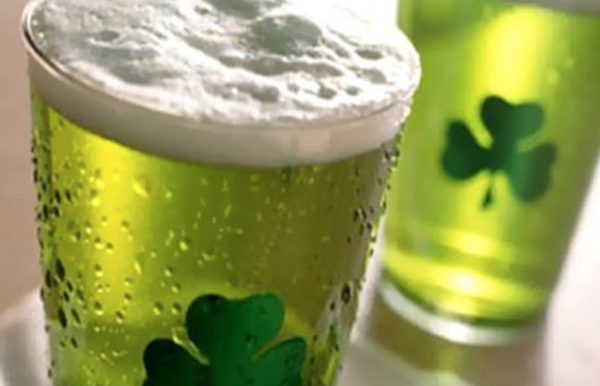Your official, pre-St. Pat’s guide to how to make green beer. Hint: it’s easier than you think.
You’ve waited your whole life for an easy DIY guide to how to make green beer, haven’t you? Today is your lucky shamrock day, because we’ve gone to the trouble of sharing all the most important beer-related secrets the internet could ever hold. You, my dear, are welcome. Cheers to your tinted drink.
We adapted the recipe from oliso.com‘s DIY beer instructions.
Let’s start out by talking about the equipment, shall we?
You’re going to need an Oliso Smart Hub for this beer recipe, but if you’re investing in one already, good news — you can make just about anything in this (chicken, meat, fish, rice, veggies, bread pudding — whatever) and it won’t be wasted cash or effort. Promise. You’ll also need a one-gallon fermentation vessel with an airlock, a muslin bag, a hose to use as a siphon, swing-top bottles, and ingredients.
Also, you’ll want to get a steam tray, hydrometer, a tool called an auto-siphon to start the siphon, and a no-rinse sanitizer like Star-San. Keep in mind you can brew endless beer all year once you have the proper materials.
Let’s make some beer mash.
The first thing you need to know when asking yourself how to make green beer, or any beer for that matter, is how to make a proper mash. The mash uses water, malted grain, and heat to create a fermentable liquid called “sweet wort.” This is when enzymes get to work converting grain to fermentable sugars. Amen, amen, amen… we’re almost at BEER!
The process is similar to making tea: heat water, mix it with milled grain, and then separate the grain from the water. If done right, the liquid that remains should be filled with sugars that the yeast will eat and turn into CO2 and alcohol.
READ MORE: There’s a BEER INTERNSHIP!
Now that we have grist, a bag, water, and the Smart Hub, we’re ready to start the mash. For this guide, we’re going to be assuming a single infusion mash, which is what is most commonly used in home brewing. We’re going to take the simple road to how to make green beer, if you don’t mind — okay?
Start by filling your Smart Top with about 1.75 gallons of water and setting the Smart Hub five or six degrees above your mash temperature, a step called “heating the strike water.” It’s important this is done correctly. Once it is at the strike temperature, adjust the Smart Hub to the mash temperature and line the Smart Top with the muslin bag (a photograph of such is included below so you can get the idea). Leave in the baffle that came with the Smart Top and place the bag on the inside of it.
Let’s get dough-in now (get it? like, let’s get goin’! we kid, we kid), which is where you mix the grains into the water with a large spoon. It’s that simple. Beer loving monkeys can do it. Pour in the grains slowly while stirring to avoid clumping. When all the grains are mixed in put the top on and wait about an hour, or whatever time your recipe calls for.
Pull the grain bag out and let it drain above the Smart Top until it stops dripping at the end of the mash (or that one hourish time period). Since it is tiring to hold the bag there, it is best to find a way to suspend it above the water. The steam tray that fits into the Smart Top is perfect, but if you don’t have one you could also use a wire rack across the top. As soon as the bag stops dripping, you’ve got fresh sweet wort.
Let’s boil now.
Let’s boil that sweet wort! Boiling the wort will sterilize it, extract proteins, work on the acids from your hops, and get rid of whatever nasties are in your brew. Honestly, the key to how to make green beer is to do it in a sanitary way, so please study the wort boiling section with diligence.
READ MORE: Hummus beer is gluten free and holy.
The Smart Top only goes up to 194 degrees F, so you need to use the Smart Hub in induction mode. Lift up the front edge and slip an index card between the electrodes on the Top and Hub to achieve this. It’s a great hack. Once that connection is broken by the index card, set the Smart Hub to level 10 and let it come to a boil.
Always leave the lid off during the boil because the evaporation will increase the gravity and bring the total volume down to a single gallon. The steam from the wort will contain compounds like DMS that won’t be pleasant in most varieties of beer. During the boil you may need to reduce the power level to 8 or 9 if it is boiling too aggressively at level 10.
Boiling sanitizes the sweet wort so everything that comes into contact with it after the boil will need to be sanitized.
You’re so cool, so your wort should be, too.
We must chill the wort so that the yeast don’t get brutally murdered by the heat. For most yeast strains, this means around 70 degrees F, but look for the recommended pitching temperature on your yeast packaging. Most importantly it reduces the chances of another bacteria beginning to colonize the wort before the yeast get established. An immersion wort chiller is the perfect way to do this; at the end of the boil just turn on the water hooked up to the chiller and the heat exchange through the chiller will bring the wort to pitching temperature in under ten minutes.
If you don’t want to build or buy a wort chiller, there are some other options. The simplest would be to fill 2 liter bottles with water, freeze them beforehand, and then sanitize them with no-rinse sanitizer right before adding them to the wort. Three 2 liter bottles should be sufficient to bring the wort to pitching temperature. If you remove the card between the Smart Hub and Top, the Hub will tell you what the temperature is as it falls so you’ll know when it’s low enough to proceed. Easy peasy.
Transfer the wort to your sterilized fermenter with a sterilized siphon. Most of the grain sediment, known as trub, should have settled in the bottom of the Smart Hub by now. On the other hand, the hops should have mostly floated to the top. Skim the hops off with a sterilized skimmer. The trub may actually help in clarifying the beer, while leaving the hops in may add bitterness. That’s on you, bro.
Let’s ferment!
The sweet wort is in the fermentation chamber so it is time to pitch the yeast! If the directions on the yeast container call for you to rehydrate it before pitching, then follow those instructions. Once you’ve done that, pour the yeast starter or dehydrated yeast into the fermentation chamber. Then put your sterilized fermenter lid with airlock into the top of the fermenter. Remember, sterilization is SO important!
Your fermenter belongs somewhere dark and somewhat warm. The fridge is a bad idea. A warm-ish corner of your kitchen that sees no light? A good idea. Use 70 degrees F as your goal. For most beers you’ll need to wait about two weeks for the proper fermentation levels. Take a gravity reading and see where you are — if it matches the recipe you’ve chosen, it’s time to get bottling.
Bottling your beer is everything, isn’t it?
Siphon your beer from the fermenter into sanitized bottles and mix it with priming sugar. You can make your own priming sugar by boiling regular store bought sugar in water, or by using a premade carbonated product. This is a good one to try, and it’s relatively inexpensive. Add one to two drops of green food coloring per bottle. Once the beer, sugar, and food coloring are in the bottle, cap it with a swing-top if using swing-top bottles, or use a cap and capper if you have those tools. Then put the bottles back in the same environment you fermented them in and wait another four weeks or so. Honestly they may be done sooner, but you can’t be sure without opening your home brews so why risk it?
Then drink it.
Weeks have passed since you first googled “how to make green beer.” You’ve put in the sweat equity, and now it’s time to drink. YASSSS.
Love this article? For more beauty, style, travel, and trending topics check out The Luxury Spot on Facebook. Like us and we’ll love you back!
















